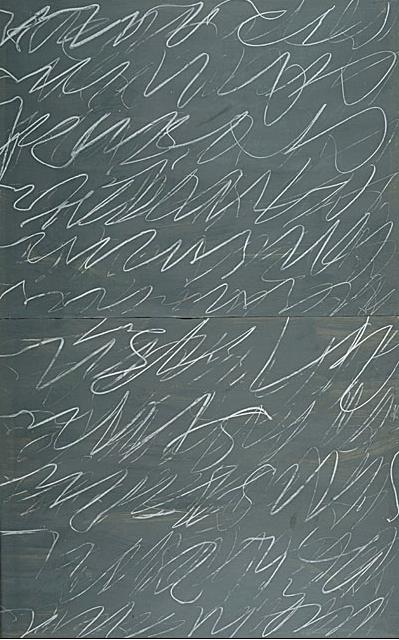While I was vacationing in London this summer, the great American modern painter, Cy Twombly died in Rome just at the time of his Twombly and Poussin exhibition opening at the Dulwich Picture Gallery.
At about the age of 17 when I came into consciousness, Abstract Expressionism was at its height. It was the grand expression of modernism, it was where all of history was leading, “the future.” Jackson Pollock, Willem de Kooning, Barnett Newman, Mark Rothko, and many more were the giants of this apparent Darwinian grand track since the Renaissance. It seemed perfectly natural, perfectly rational where lines and colors lose their known reality and become pure sensation, a vortex of stop-motion emotionality, the future world. But of course there would be many future worlds. And yet for me, Abstract Expression would remain the magnet, the spiritual well that was both irresistible and not truly understood; no, not understood, but embraced. And what is Cy to me? Quite simply, his art was an exquisite resolution.
Cy Twombly managed to bridge these future worlds and even daringly, unflinchingly looked back and did not turn to salt. He instinctively, at a time that seemed out of kilter, devised a craft of seeing and marking like none other. He would defy the critical weight of the ensuing changes and transformations managing to be irreverent, the elusive enfant terrible of late abstract expression movement with the likes of Jasper John and Robert Rauschenberg. Early in his career, Twombly would leave New York for Rome. Remaining essentially an abstractionist with his Greek, Roman and literary references, that enduring shadow over western culture, he would make the past connect. He would lay this history within our aesthetic world, prepared to accept the intrinsic mystery as a living past that remains with us, timeless. Like an errant asteroid, Twombly ricocheted off various contemporary ‘isms’ creating his own vital, electric weather with acts of gestural spontaneity in dreamy cascades of lines erased, smeared; or colors dragged and blotched, canvases lush or nude and sometimes spare, sometimes erotic, cryptic paintings where one is held hostage, so to speak, inside raw skittish paradoxes of paint, pencil and barely discernible words, ingesting myth, history and nature.
My most intimate and enduring impression of Twombly's paintings was while guarding them during the inaugural opening of the Broad Contemporary Art Museum at LACMA in 2008-09. For a year, I lived in a room full of his art, from his earliest paintings all the way up to 2007--many of which are now on view in Cy Twombly's tribute exhibition at MOCA. All retained that original cryptic impulse with combustible markings, graffiti like, impasto paint exploding on the canvas. So to experience this once again the grand gesture with even bolder literalness and fearless color was to be back almost where I started. The Dulwich show, which went under the title of Twombly and Poussin: Arcadian Painters, was breathtakingly beautiful. In the catalogue, the figures # 38 & #40 had been at the Broad. And at present in LACMA on show in the modern gallery is a work on paper known as Roman Notes, 1970, which would fall under the title of “Anxiety and Theatricality” in the Dulwich show where there were similar works.

Cy Twombly (1928-2011), Roman Notes #3, 1970. Drawing, gouache, oil crayon on paper. Gift of Robert H. Halff through the Modern and Contemporary Art Council (M.2005.38.38)
Even today, after all the gazing, perusing and speculative intellectual dissonance stuff, I am still left with this baffling gap between spectacle and revelation. In spite of Twombly’s hero, Poussin’s fictive landscapes of graceful gods imitating scenes of mythology, I knew all too well that I am capable only of being seduced by the sheer, unadulterated glamour. For its more esoteric emotions and meanings seem out of reach, a cultural leap of pretense, at best. Failing inadequately to find more, to piece together the sensuousness, and the utterly vivacious, beguiling puzzle, I suspect that if one desires to do more than to be merely entertained it is to believe that art is some kind of religion. Maybe this is all Cy Twombly, a visionary giant, could have left us with, a body of gorgeous, voluptuous signs.
Hylan Booker



